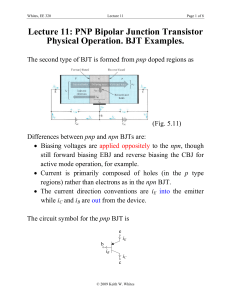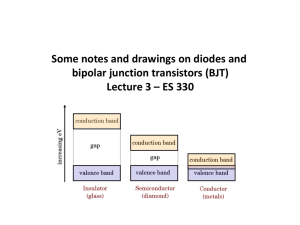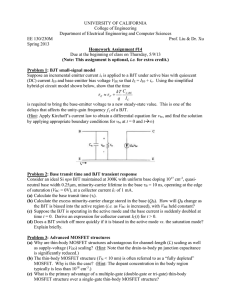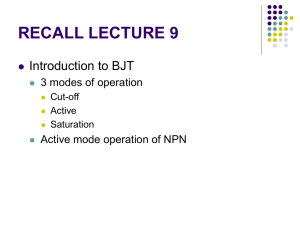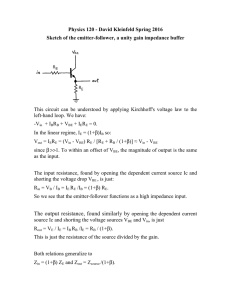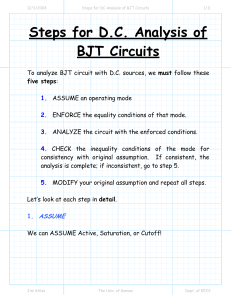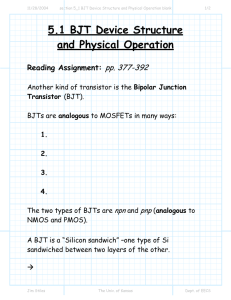Lecture 11: PNP Bipolar Junction Transistor Physical Operation. BJT
advertisement
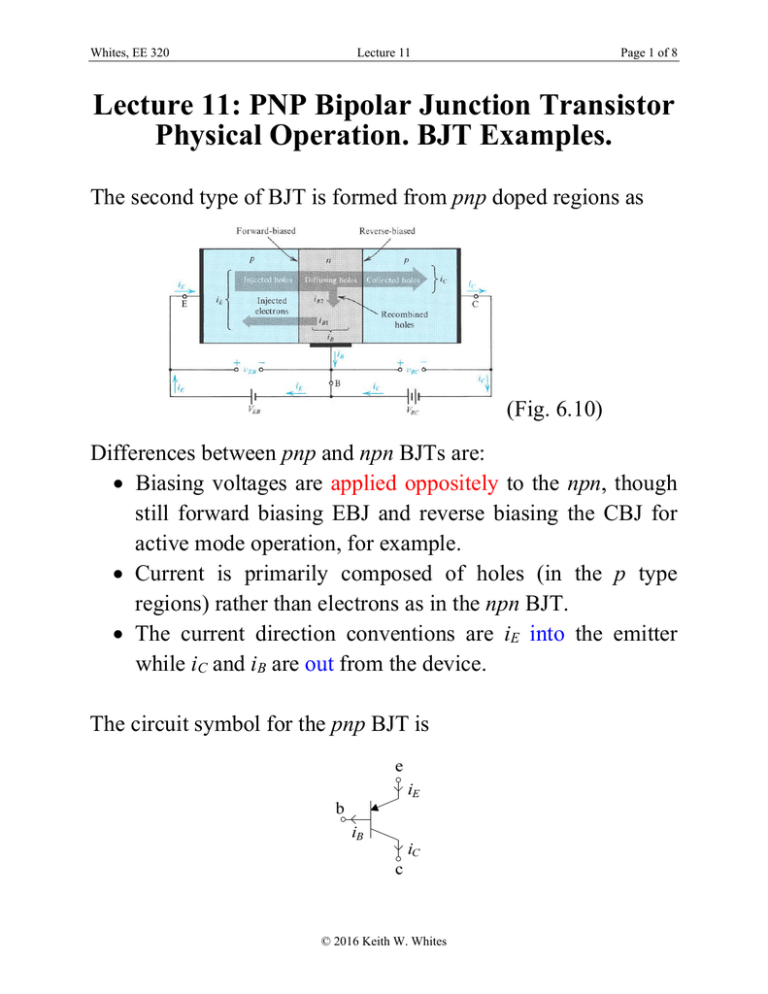
Whites, EE 320 Lecture 11 Page 1 of 8 Lecture 11: PNP Bipolar Junction Transistor Physical Operation. BJT Examples. The second type of BJT is formed from pnp doped regions as (Fig. 6.10) Differences between pnp and npn BJTs are: Biasing voltages are applied oppositely to the npn, though still forward biasing EBJ and reverse biasing the CBJ for active mode operation, for example. Current is primarily composed of holes (in the p type regions) rather than electrons as in the npn BJT. The current direction conventions are iE into the emitter while iC and iB are out from the device. The circuit symbol for the pnp BJT is © 2016 Keith W. Whites Whites, EE 320 Lecture 11 Page 2 of 8 Once again, the filled arrow is always located on the emitter and helps us to remember the direction of the emitter current. Notice that the currents are pointed in opposite directions compared to the npn BJT. For biasing in the active mode, a possible circuit is (Fig. 6.13b) As with the npn, for the pnp BJT in the active mode and with the current convention shown above iC iE (6.7),(1) iB 1 iE iC iB 1 1 (2) (6.2),(3) (6.10),(4) (6.8),(5) Consequently, we need to only memorize this one set of equations for use with both npn and pnp BJTs, plus the current conventions for these two BJTs. Whites, EE 320 Lecture 11 Page 3 of 8 Examples We’ll now consider a few examples of the DC analysis of npn and pnp BJT circuits. Example N11.1 (text Example 6.2). Design the following circuit so that I C 2 mA and VC 5 V. For this particular transistor, = 100 and VBE 0.7 V at I C 1 mA. (Fig. 6.15) The “design” of this circuit is to determine the RC and RE that provide the specified IC and VC. For IC = 2 mA, then 15 VC 15 5 2 mA or RC 5 k. 3 RC 2 10 Whites, EE 320 Lecture 11 Page 4 of 8 We’re assuming that the transistor is in the active mode with the EBJ forward biased and the CBJ reversed biased. For the forward biased EBJ junction, vBE VT iC I S e (6.1),(6) It’s given that at IC = 1 mA, VBE = 0.7 V. What is VBE when IC = 2 mA? Using (6) for two different iC and vBE we find that vBE 1 vBE 2 iC1 iC1 vBE1 vBE 2 VT ln e or iC 2 VT iC 2 Therefore, i vBE 2 vBE1 VT ln C1 (7) iC 2 For this particular case, 2 VBE 2 0.7 25 103 ln 0.717 V 1 This is not much of an increase from 0.7 V, which is what we typically observe when the BJT is in the active mode. (It’s common to assume VBE 0.7 V when a BJT operates in the active mode.) Consequently, Next, VE 0.717 V iC iE iE iC 1 iC Whites, EE 320 then Lecture 11 IE Page 5 of 8 100 1 2 mA or I E 2.02 mA 100 We can use this emitter current to select the proper resistor RE: VE 15 V IE RE 0.717 15 or RE 7.07 k 2.02 103 That completes the design. One last thing, though. Notice how small the base current IB is relative to IC and IE: I B I C I E 20 A. This is typical of BJTs operating in the active mode. Example N11.2 (text Exercise 6.13). Determine IE, IB, IC, and VC in the circuit below if = 50 and VE = -0.7 V. Whites, EE 320 Lecture 11 Page 6 of 8 (Fig. E6.13) Because VB = 0, then the given VE means the BJT may be operating in the active mode since VBE = 0.7 V. (It could also be operating in the saturation mode.) We’ll assume active mode operation for now, and confirm this assumption when we’re finished. (i) Compute IE. IE (ii) Compute IC. IC I E 0.7 10 0.93 mA 10,000 1 IE 50 0.93 mA=0.91 mA 51 (iii) Compute IB. IC I B I B (iv) Compute VC. IC 0.91 mA 18.2 A 50 VC 10 5,000 I C 5.45 V Whites, EE 320 Lecture 11 Page 7 of 8 Note that since VCB VC VB 5.45 0 5.45 V is greater than zero (thus reverse biasing the CBJ) and the EBJ is forward biased, the npn BJT is indeed operating in the active mode, as assumed. Example N11.3 (text Exercise 6.14). Given that VB = 1.0 V and VE = 1.7 V, determine (and ) for the transistor in the circuit below. Also calculate VC. (Fig. E6.14) Because VEB VE VB 0.7 V, the pnp transistor may be operating in the active mode, which is what we will assume. (i) Determine and . We’ll use the relationships iC iE and iC iB to determine and . From the circuit, IB VB 1.0 10 A 3 3 100 10 100 10 Whites, EE 320 Lecture 11 IE and Page 8 of 8 10 1.7 1.66 mA 5,000 Using KCL: I C I E I B 1.66 103 10 106 1.65 mA. Therefore, I C 1.65 103 165 6 IB 10 10 I C 1.65 103 0.994 3 I E 1.66 10 and Alternatively, 1 0.994 (ii) Compute VC. or VC 10 V 5,000 I C 10 V 5,000 1.65 103 VC 1.75 V. Note that this VC means that the CBJ is reversed biased by the voltage 1.0 1.75 2.75 V. Hence, the active mode operation for the pnp BJT is the proper assumption since we’ve already determined that the EBJ is forward biased.
